#Software Containers
Explore tagged Tumblr posts
Text
company: we are very accessible we even have a tool that automatically generates alt text the alt text in question: an image of some kind. maybe a screenshot.
#pure gold takes by ME#in ms word rn and they were like 'we generated alt text for this to accomodate blind people' and i shit you not the alt text says#'a picture that contains text screenshot software website'#thank you word im sure they will appreciate it
46 notes
·
View notes
Text

Look what I found!!!
His name is benzyne. Here's a cool article about him:
https://www.acs.org/molecule-of-the-week/archive/b/benzyne.html
Mind blown when I saw him in scifinder. Didn't think he could exist on account of strain (he kind of can't lol) but lookit him go! So cool. New favorite molecule sorry benzil
#big fan of aromatics#big fan of rings#lookit !!#made the molecule with a software i forgot the name of#I'm so tired hahaha but i couldn't contain my excitement when i read about him#so cool#isn't he so cool#chem posts chem
6 notes
·
View notes
Text
How a Container Terminal Operations System (CTOS) Enhances Port Efficiency
Table of Contents
Introduction
The Evolution of Vessel and Terminal Operations
The Role of a Container Terminal Operating System (CTOS) in Efficiency
Key Factors Influencing Port Efficiency
The Strategic Importance of a CTOS
Envision (iPortman) CTOS: The Future of Port Management
Conclusion
The Evolution of Vessel and Terminal Operations
With growing international freight volumes, freighters are increasingly larger and quicker. Shippers require lower shipping costs, but shipping companies look to decrease the cost of shipping per unit. Reducing vessel turnaround at ports has emerged as an extremely effective measure of cost-saving, and therefore terminal operators have turned to the most advanced container terminal automation technology. Hence, it is necessary to invest in new container terminal operating systems (CTOS) and new infrastructure for improved efficiency as well as dock reduction time.
The Role of a Container Terminal Operating System (CTOS) in Efficiency
With the highly competitive environment, effective terminal operations are essential to retain a competitive advantage. Though capacity expansion of the terminal has been the focus, terminal management software tends to get neglected. A robust container terminal operating system (CTOS) is essential to automate processes and improve service levels.
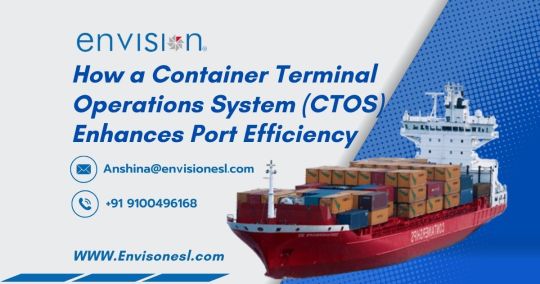
The primary features of a CTOS are:
Optimized Container Movement Management: Accurate placement of containers within the terminal.
Automated Loading/Unloading Scheduling: Optimizing the utilization of container yard management systems based on real-time shipping data.
Seamless Multi-Modal Integration: Enabling unproblematic road, rail, and sea transportation mode transfers through automated gate system support.
Improved Communication: Providing stakeholders with precise container tracking software updates.
Key Factors Influencing Port Efficiency
Container terminals play a critical role in international logistics by managing cargo handling and intermodal transfers. Several factors impact port efficiency, including:
Yard Size & Layout: Directly influencing storage capacity and movement optimization.
Maritime, Road, and Rail Connectivity: Ensuring efficient cargo transfers between transport networks.
Advanced Machinery: Boosting operational productivity and enhancing automated gate system performance.
Container Terminal Operating System (CTOS): A foundational tool that streamlines operations, from vessel planning and optimization to yard truck management system implementation.
The Strategic Importance of a CTOS
Maximizing efficiency and minimizing costs are key issues for terminal operators. Container terminal operating system (CTOS) simplifies container handling, making cargo flow smooth.
The key benefits of CTOS implementation include:
Reduced Vessel Turnaround Time: Faster cargo handling increases port calls and enhances throughput.
Revenue Optimization: Efficient asset utilization and automated invoice processing improve financial performance.
Lower Operating Costs: Reducing manual operations and leveraging container terminal automation minimizes expenses.
Maximized Resource Utilization: Optimizing asset allocation across yard truck management systems and depot management system (DMS).
Enhanced Transparency & Collaboration: Real-time reporting strengthens stakeholder communication, improving customer satisfaction.
Envision (iPortman) CTOS: The Future of Port Management
Envision’s iPortman CTOS is designed to meet today’s operational needs while future-proofing port efficiency.
Key advantages include:
Modular Architecture: Adaptive module-based deployment for scalable container terminal operating system expansion.
Comprehensive Cargo Handling: Supporting imports, exports, and container freight station software (CFS) integration.
All-in-One Port Management: Unifying all operations under a single platform, including vessel planning and optimization.
Mobile App Support: Enhancing real-time data collection and reducing back-office delays.
Customer Portal Integration: Increasing transparency, stakeholder collaboration, and satisfaction.
Advanced Planning & Optimization: Strengthening efficiency in depot management system (DMS) and yard truck management system deployment.
High-Level Reporting Features: Enabling key information about cargo activities, gate transactions, and performance of automated gate systems.
Conclusion
The use of an advanced container terminal operating system (CTOS) is necessary for maximizing port efficiency, lowering costs, and fueling revenue growth. Envision’s iPortman CTOS presents a comprehensive, future-proof solution that enhances transparency, productivity, and terminal operations. In today’s competitive global logistics environment, investing in a sophisticated CTOS, along with container yard management system and container freight station (CFS) software, is no longer optional—it’s a necessity.
#container terminal operating system#container terminal automation#container tracking software#vessel planning and optimization#depot management system (DMS)#container freight station (CFS) software#AI-powered port management#multi-cargo terminal operating system
1 note
·
View note
Text











Fog
#horizon forbidden west#hfw#hfw photomode#thornmarsh tuesdays are back!#(at least for this week)#i haven't actually been spending much time here#too many fireclaws#and not enough sac webbing#also got spotted by the fireclaw at the huge container/cart site#because i peeked out of the grass for half a second#and then wasn't entirely concealed by it due to a slope#at least i think that's what happened#i took a video of the thing#and still don't quite understand#because at no point of this was the fireclaw visible to me#until it just loomed over me like 'i see you'#it was an apex one too#maybe heph just got them infrared vision#snake software on bear hardware#who knows at this point
24 notes
·
View notes
Text
i have a new hobby! i enter a random word into youtube music's searchbar and scroll until i find songs with 0 listens and then vibe :3
#just me hi#ough the soundssssssssssssssssssssssssss#i already spend like hours just browsing and vibing why not find new stuff !!#i have found a couple that i love ouuuuuu#it's a lotta fun i just shouldn't have started doing this last night at 11 LMfhsfhvj#only thing is that's it So annoying bc ytm doesn't let you filter by listens so you have got to scroll for a bajillion years :/#which is fine. on a phone :) makes sense why i never thought to do this on my puter tho kfshvhfjs#/okay wait no there's another thing WHYYYY do these people never have lyrics listed#i KNOW you prolly think 'ah who will need them? :/' ME. I NEED THEM#i can't understand unfamiliar voices dude i need HELP#/<- fully realized this at work like a couple weeks ago when people kept trying to talk to me and it wasn't computing Fjsgjsfhgj#like it takes like 3-5 conversations until it doesn't take effort. functional software 👍💥#//but anywhooooooooooooooooo BIRDS#i love albatross. looking at them with my big eyebolls#they're neat. and. cool#was reading the wikipedia for them yesterday and i contain bird knowledge :)#almost started rambling to my mother abt them like i was 5 again hjfshgjs#i like them. [the eyeballs]#//and i have gotta finish this funkin thing i'm working on but i need to make a DECISION. something i am Historically bad at lmaoo#i have used the trusty spinny wheel and discarded it's hallowed opinion. asked my brother and you know what he has a point actually so#m gonna get on it. but let it be known. i am chewing through tires as i drag myself through it hjfhsgjjfs#/but YEAH here i go Toodles !! ~+~+~+~
1 note
·
View note
Text
when you've been rotating the Perfect birthday gift for somebody in your mind for Literal Years but you can't bring yourself to make it bc you know that this person's temper will end up making them break it if it doesn't act perfectly 100% of the time, then blame it for not being sturdy enough to take it. regardless of how much heart and soul you put into it.
#portal#rosie rambles#i Need to make a portal radio with little easter eggs in it So Bad orz#best idea for armor i have so far is making the internal machinery as self-contained and small as possible#and then making a radio plushie around it (with spots for the actual interface to still peek through)#but then that runs the risk of overheating and possibly a fire hazard if i do the wiring poorly enough#augh. it could have a little software doohickey that would check if it got tuned below legal usa FM and switch over to a thing that would#let it 'tune in' to the actual frequency shown in-game with just a loop of the music for forever.#unless within the vicinity of a specific NFC chip at which point it would activate a script to override the tune with the SSTV files from#the pre-portal-2 update. or custom ones i am (metaphorically) BEATING MY FACE iNTO THE WALL IT WOULD BE PREFECT BUT BE SO BREAKABLE#then again. there are a few things that have survived longer than i'd ever expected them to. idk. i just. AARARARARAARGH#then again again. i'm broke as balls and still need to somehow scrounge up bike money
6 notes
·
View notes
Text
me last time i was high: fuck it im going to make a movie ill shoot everything now and then edit sober like the great writers do. that way i won't be too anxious to get a bunch of great footage i can work with later
the great footage in question:
#there's also a video of me slowly zooming in on a chair and a 20 second video of a sharps container on my table.#i do vividly remember deciding to shoot a movie and edit it sober but i do not remember filming any of these clips. 👍#thank you me for this incredible raw material im sure i can use it for something revolutionary#itll be the atman 1975 of digital video software.#avpost#sorry i like just found this today. in my camera roll. and im losing my mind.
5 notes
·
View notes
Text
To differentiate between a .jar file and a Java web application in a Linux environment...
It’s essential to understand their configurations and structures along with the relevant networking considerations. A .jar (Java Archive) file is typically packaged with a manifest file (META-INF/MANIFEST.MF) that may include a “Main-Class” attribute for executable applications. When executed in Linux, it can be run using the command java -jar yourfile.jar, relying on the Java Runtime Environment…
#Apache Tomcat#http#HTTPS#internet protocols#JAR file#java#Java programming#Java runtime environment#Java web application#Jetty#linux#Linux commands#networking protocols#server deployment#servlet container#software packaging#WAR file#web application deployment#web development#web server configuration
0 notes
Text
Docker Guide: Introduction, Benefits, and Basic Example
This comprehensive guide offers an accessible introduction to
Docker, a powerful platform for developing, shipping, and running applications in isolated environments. We'll demystify what Docker is, explore its key benefits such as portability, scalability, and efficiency, and walk you through a practical, basic example to get you started with containerization.
#Docker #Containerization #DevOps #Introduction #Benefits #Example #Tutorial #Beginner #SoftwareDevelopment #ApplicationDeployment #Virtualization #Microservices
0 notes
Text
How Smart Ports Are Revolutionizing Global Trade Through Cloud and AI
Introduction to Smart Ports in Global Logistics
In the global logistics setting, ports serve as pivotal nodes linking maritime trade with inland transport. Global trade volumes rising and supply chains growing ever more complex have made the older port infrastructure less appropriate to meeting logistical demands. This interconnected world is for the birth of a new generation of smart ports-a port system digitally empowered by automation for aids of speed, accuracy, and efficiency while solving modern logistics problems.
For industrialists and logisticians, this is far from a mere technological trend; it is rather a transformational shift that reorganizes the concepts of competitiveness, sustainability, and operational control. Essentially, the smart ports, powered by new technologies such as cloud-based logistics solutions, digital twins in logistics, enterprise IT asset management, and logic-based advanced analytics, open the door to a transparent and resilient supply chain ecosystem.
Understanding the Smart Port Ecosystem
Smart port refers to the application of digital technologies together with data coalesced and intelligent automation to optimize various activities of port operations and related services, including vessel traffic, cargo movement, yard management, customs clearance, and more multimodal transportation.
Unlike traditional ports, smart ports are:
Connected: Systems are integrated across stakeholders.
Data-Driven: Decision-making is supported by real-time analytics.
Predictive: Disruptions are anticipated through forecasting models.
Automated: Tasks such as gate entry, cargo handling, and yard operations are automated.
Sustainable: Energy consumption and emissions are monitored and optimized.
The technology stack that enables the abovementioned capabilities comprises AI, IoT, 5G connectivity, cloud computing, digital twin, blockchain, and machine learning.
Cloud-Based Logistics Solutions: The Digital Backbone
The transformation into smart port operations began with cloud-based logistics solutions, since these provide the requisite scalability, interoperability, and agility for the operations of the modern port.
Cloud platforms allow ports to:
· Centralize data across shipping lines, customs, truckers, and terminal operators.
· Enable real-time collaboration among all stakeholders.
· Reduce dependency on on-premise infrastructure and manual workflows.
· Ensure business continuity through remote accessibility.
With such a cloud-based logistics tool, ports can instantly gain visibility into cargo movement, automate documentation, and remove data silos. Also, cloud computing speedily enables the installation of novel technologies such as presence execution software and visibility platform, forming the core of a smart port ecosystem.
How Cloud Computing Has Changed Business in Port Logistics
Cloud computing has dramatically changed how ports and logistics companies operate. The question, how cloud computing has changed business, is best answered through tangible operational improvements:
Real-Time Decision Making: Cloud platforms facilitate faster data processing, enabling immediate action during disruptions.
Global Access: Operators and logistics managers can access systems securely from anywhere, enhancing flexibility and responsiveness.
Lower IT Costs: With no need for expensive physical servers, ports benefit from predictable, pay-as-you-go pricing models.
Seamless Integration: Cloud systems integrate with third-party apps, IoT devices, and automation platforms easily.
Data-Driven Culture: Cloud computing supports big data analysis, turning operational insights into strategic actions.
To answer how has cloud computing changed business, it’s clear: it has enabled smarter, faster, and more connected operations.
Enterprise IT Asset Management in Smart Ports
Smart ports rely heavily on a complex IT ecosystem involving networks, sensors, control systems, and software applications. Managing this digital infrastructure is vital. That’s where enterprise IT asset management comes in.
This function enables ports to:
· Monitor the health and performance of all IT assets.
· Ensure timely maintenance and upgrades of hardware and software.
· Track usage and prevent redundancy.
· Optimize asset lifecycle and reduce downtime.
· Maintain cybersecurity and regulatory compliance.
Through effective IT asset management, ports can ensure that digital systems — from automated cranes to data servers — function reliably and efficiently.
Digital Twins in Logistics: Virtualizing Real-World Port Operations
One of the most transformative technologies in the smart port realm is the use of digital twins in logistics. A digital twin is a dynamic, virtual replica of a physical asset or system, such as a container yard, crane, or terminal.
By using digital twins, ports can:
· Monitor operations in real time using sensor data.
· Simulate scenarios like peak congestion or equipment failure.
· Perform predictive maintenance on critical assets.
· Enhance training and safety procedures.
Even more powerful is digital twin fleet management, where port authorities and shipping lines can monitor vessel performance, optimize routes, reduce fuel consumption, and lower emissions. This contributes not only to efficiency but also to sustainable port operations.
Transportation Analytics Platform: Powering Predictive Intelligence
A key feature of smart ports is their ability to predict and preempt problems before they escalate. A transportation analytics platform uses AI and machine learning to analyze massive datasets collected from port sensors, logistics systems, and vessel tracking platforms.
Such a platform helps ports:
· Forecast container throughput and resource needs.
· Analyze patterns in dwell times and berth utilization.
· Identify inefficiencies and areas for improvement.
· Make data-backed decisions on investments and expansions.
Transportation analytics is the compass that guides a port’s long-term strategic planning and day-to-day operational adjustments.
Transportation Execution Software: The Operational Core
While analytics helps with planning, execution requires precision tools. Transportation execution software ensures that everything from container unloading to gate scheduling is managed in real time.
Key functionalities include:
· Scheduling deliveries and dispatches.
· Managing container pickups and drop-offs.
· Coordinating with trucking companies and rail operators.
· Generating documentation like bills of lading.
· Updating stakeholders on cargo status in real time.
By integrating this software with cloud platforms and IoT devices, smart ports can streamline throughput and reduce turnaround times.
Visibility Platform: The Digital Control Tower
A visibility platform is the command center of smart port logistics. It aggregates data from various systems into a unified dashboard, giving real-time status updates on:
· Container locations and movement
· Yard inventory
· Crane performance and downtime
· Weather and tidal conditions
· Vehicle and equipment availability
Real-time visibility allows port managers to respond quickly when delays, equipment failures, or environmental hazards materialize. It also supports long-term performance benchmarking and continuous improvements.
Enterprise Order Management: Connecting Supply and Demand
The actual core of global trade is the actual fulfillment of an order, accurate and timely. The Enterprise Order Management system tries to plug discrepancies between sales, inventory, transport, and customer service.
In the context of smart ports, order management systems:
· Synchronize cargo arrival with warehouse availability.
· Provide EDI integration with customer and carrier systems.
· Automate invoicing, customs clearance, and compliance checks.
· Optimize container space usage and reduce deadhead runs.
With smart ports playing a pivotal role in order fulfillment, efficient enterprise order management is a key driver of customer satisfaction and profitability.
Digitalization of Manufacturing and Smart Ports
As Industry 4.0 takes root, the digitalization of manufacturing is reshaping logistics demands. Smart factories now require ports to deliver components just in time, with complete traceability.
Smart ports support this by:
· Integrating digitally with manufacturing supply chains.
· Providing real-time updates on inbound raw materials and outbound shipments.
· Enabling flexible berth scheduling to accommodate dynamic production cycles.
· Supporting robotic handling for rapid loading/unloading.
Ports are no longer passive handoff points — they are active participants in the digitalization of manufacturing supply chains.
Communication Terminal Content Freshness Management
An essential yet underappreciated element of smart port systems is communication terminal content freshness management. This refers to the continuous updating of digital information shown on terminals, dashboards, and communication panels.
Ensuring content freshness means:
· Operators always act on accurate, real-time data.
· Decision-making is based on current conditions, not outdated metrics.
· Miscommunication is minimized in high-pressure environments.
For example, if a crane operator sees stale data about container placement, it can lead to misplaced cargo or safety incidents. Hence, robust content freshness management is critical in every smart port.
Choosing the Right Enterprise Solutions Company
Successfully building a smart port ecosystem requires the right technology partners. A competent enterprise solutions company brings:
Industry-specific expertise in port operations and logistics.
Proven experience in implementing cloud systems, analytics, and IoT.
Scalable platforms that adapt to the port’s growth.
End-to-end support from system design to post-deployment optimization.
Be it integrating transportation-management-software or implementing a visibility platform, the partner you choose weighs significantly on a port’s digital transformation succeeding or failing.
Destiny: Proclaiming the Smart Ports
Smart ports are no longer a future prospect. They are, in fact, a present-day reality, reshaping the entire universe of global trade and logistics. Through cloud-based logistics solutions and digital twin fleet management, these intelligent ecosystems enable the ports to work with unmatched efficiency, transparency, and resiliency.
As ports continue to embrace the likes of enterprise IT asset management, enterprise order management, and transportation analytics platforms, they begin to transcend operational silos and become interconnected hubs of innovation. In a world of growing demand for speed, accuracy, and sustainability, the ports that choose today to embrace the smart technologies will rule tomorrow’s logistics space.
The way forward for industrialists and logistics professionals is crystal clear: invest in smart-port technologies, work with an enterprise solutions company that knows its value, and support that value across every node of the supply chain.
Conclusion: Embracing the Smart Port Era with Envision
As global trade evolve , so must the infrastructure that enables it. The era of smart ports is no longer a distant vision — it’s today’s reality. Across landmasses, ports are changing into smart logistics hubs by using cloud-based solutions for logistics, digital twins in logistics, and managing enterprise IT assets. These technologies are not just improving operational efficiency. They are also establishing a new standard for transparency, flexibility, and sustainability in maritime logistics.
By combining systems like a conveyance analytics platform, transportation execution software, and a unified visibility platform, port operators gain predictive insights, real-time control, and complete operational visibility. And with tools such as enterprise order management and communication terminal content freshness management, smart ports can ensure accuracy, compliance, and seamless stakeholder communication across the supply chain.
One solution leading this revolution is Envision Smart Ports — an advanced platform built to digitally empower port operations with AI, IoT, cloud, and automation. Envision Smart Ports delivers a cohesive digital ecosystem tailored to the modern needs of port logistics, offering modules that align with all facets of the smart port transformation.
Whether you are exploring the digitalization of manufacturing, implementing digital twin fleet management, or seeking guidance from a reliable enterprise solutions company, Envision provides end-to-end expertise to accelerate your port’s digital journey.
Take the Next Step
Are you ready to lead in the age of smart port automation?
Discover how Envision Smart Ports can help you update your port infrastructure with scalable, future-ready solutions. Connect with us today to begin your journey toward smart, strong, and fully connected port operations.
#artificial intelligence#container#digital transformation#terminals#envision smart ports#smartports#maritime#software#software engineering#management#envision smartports
0 notes
Text
Top 10 Reasons Why Envision GTOS Leads the Container Terminal Operating System Market
In an era characterized by unruly growth of worldwide commerce, the efficiency of seaports, inland terminals, and cargo depots has been the factor ensuring that international trade stands on its weak legs. It would have been very much in demand right now while cargo volumes kept surging for smarter, more scalable, and technologically advanced solutions. Enter GTOS or General Terminal Operating System-a digital framework that aims to evolve the ways in which the terminals operate.

Leading the way in this transformation is the Envision GTOS platform-it is said to be the platform of the future by Envision Enterprise Solutions. In this in-depth blog post, we will dissect the GTOS concept; we shall state why it matters, go into the details of Envision GTOS's features, and explain how it stands taller than traditional systems. We'll also cover how Envision's commitment to smart integration and digital transformation continues to reshape the future of terminal management.
What is GTOS?
GTOS (General Terminal Operating System) is a software system used to manage and optimize the daily operations of cargo terminals. It serves as the digital brain behind terminal logistics, orchestrating processes such as:
• Cargo intake and dispatch
• Gate operations
• Yard management
• Equipment control
• Vessel planning
• Documentation and invoicing
• Real-time tracking and tracing of containers
This system, therefore, applies to container as well as general cargo, breakbulk, Ro-Ro, and bulk terminals. Its main objective is to automate manual processes, reduce operational errors, and improve throughput. The flexibility of GTOS allows it to be used in a variety of terminal environments, adjusting to regional and cargo-type-specific needs.
The modern GTOS is evolving to handle the intricacies of hybrid cargo types, multiple modes of transport (rail, road, and sea), and rapid digitization demands from customs and regulatory authorities. It also facilitates seamless integration with external systems like ERP platforms, shipping lines, and government portals, making it the hub of smart terminal ecosystems.
Importance of GTOS in Cargo and Terminal Management
1. Operational Efficiency
A robust GTOS minimizes manual data entry and speeds up cargo movements, helping terminals handle higher volumes without increasing overhead. This is crucial in today's environment where terminal congestion can delay entire supply chains. With precise control over gate, yard, and berth operations, GTOS reduces downtime and improves cargo turnover rates.
2. Real-Time Visibility
This GTOS platform acts as a brain by providing a set of interfaces giving one real-time information about cargo location, equipment status, and venue schedule. This visibility is crucial in making operational decisions swiftly, deterring demurrage, and improving customer satisfaction. It also supports instant exception handling and performance monitoring.
3. Standardization & Compliance
Having an inbuilt integration for customs, billing, and safety protocol applications, GTOS enables terminals to effortlessly observe some regulations. Documentation is generated automatically, stored, and made traceable for the purpose of customs clearance and audits.Terminals can configure regional rules and port-specific compliance requirements, reducing legal and financial risks.
4. Data-Driven Insights
Modern GTOS platforms offer advanced analytics to evaluate KPIs like berth productivity, truck turnaround time, and equipment utilization. These kinds of insights assist in long-range planning, Predictive maintenance, and short-term adjustments on an operational level. These predictive algorithms can identify bottlenecks as they begin and also provide excellent forecasting tools.
5. Scalability and Flexibility
As terminal volumes grow, GTOS platforms can scale through modular upgrades. Whether it’s expanding yard space or integrating new technologies, GTOS provides the necessary backbone. Its modular architecture supports future extensions without interrupting live operations. Additionally, cloud-based systems enable global access and updates.
Who Uses GTOS?
GTOS solutions are used by a wide array of stakeholders in the global logistics chain:
Seaports and Terminals: To manage inbound and outbound container traffic, bulk handling, and equipment scheduling.
Inland Container Depots (ICDs): For handling hinterland cargo flows, customs clearance, and road/rail interface.
Container Freight Stations (CFS): To manage less-than-container-load (LCL) and de-stuffing operations.
Bulk Cargo Handlers: For managing grain, coal, and ore cargoes through conveyors, silos, and hoppers.
Shipping Lines & Freight Forwarders: For digital visibility, pre-arrival documentation, and EDI.
Customs and Port Agencies: For digital inspection clearance, security checks, and regulatory control.
Private Logistics Parks: For freight forwarding, warehousing, and integrated operations spanning trucking.
Essentially, implementing a GTOS might be of great advantage to any organization that manages large cargo volumes or demands efficiency, traceability, and regulatory compliance.
Core Features of a Normal GTOS
A standard or traditional GTOS includes the following features:
Gate Automation
Utilizes OCR (Optical Character Recognition), RFID (Radio-Frequency Identification), and ANPR (Automatic Number Plate Recognition) technologies to automate vehicle entry and exit processes. It reduces human involvement and accelerates truck turnaround time.
Yard Management
Optimizes the placement of containers and general cargo. Assigns space dynamically, schedules equipment, and ensures optimal yard utilization. It prevents mishandling and streamlines stacking and retrieval processes.
Vessel Planning
Allocates berths, schedules quay cranes, and manages stowage planning based on vessel arrival times and cargo manifests. Efficient vessel turnaround enhances port reputation and throughput.
Cargo Handling
Manages the loading and unloading process, ensuring minimal damage, efficient use of cranes and forklifts, and faster truck turnarounds. Smart task allocation and job execution tracking boost productivity and safety.
Billing & Invoicing
Tracks all chargeable activities—such as storage, handling, and demurrage—and generates automated invoices. Integrates with accounting systems for audit-ready documentation. Multi-currency and tax logic are often included.
Reporting Tools
Provides dashboards and reports for analyzing operational metrics. Often used by managers to evaluate performance and make data-backed decisions. Advanced systems can export data for machine learning models and predictive algorithms.
Benefits of GTOS in Terminal Operations
Higher Throughput
By automating repetitive tasks and optimizing cargo flows, GTOS enables terminals to handle more cargo in less time. This makes it easier to handle peak season volumes without service degradation.
Lower Operational Costs
Less dependency on manual labor and better utilization of equipment leads to significant cost savings. Resource optimization reduces energy consumption and maintenance overheads.
Improved Customer Service
Faster processing and real-time updates improve customer satisfaction. Terminals can provide clients with live tracking, automatic alerts, and digital documentation.
Enhanced Safety
Automated systems reduce human involvement in hazardous areas, lowering the risk of accidents. Integrated safety compliance ensures secure cargo movement. Risk assessments and safety drills can also be managed through GTOS.
Environmental Benefits
Efficient terminal operations reduce fuel consumption and emissions, supporting green port initiatives. Energy-efficient equipment scheduling and paperless documentation also contribute. Sustainability dashboards allow ports to monitor and improve their carbon footprint.
Envision GTOS: Redefining Terminal Efficiency
Envision GTOS is designed with a future-ready architecture that incorporates AI, IoT, and cloud computing to deliver next-level efficiency. Here’s how it surpasses traditional GTOS systems:
AI-Powered Decision Making
Predictive analytics and machine learning algorithms optimize berth planning, equipment usage, and yard allocation. AI-driven recommendations ensure proactive management and faster cycle times.
Real-Time IoT Integration
Integrates with smart sensors and IoT devices to provide real-time data on container conditions, equipment health, and yard congestion. It supports real-time alerts and automated escalation.
Cloud-Native and Mobile First
Accessible from anywhere, Envision GTOS supports mobile devices for on-the-go monitoring, approvals, and task management. It supports hybrid cloud environments and multi-terminal operations.
Blockchain for Document Security
Utilizes blockchain for secure, immutable documentation and transparent cargo movement records. This enhances stakeholder trust and compliance.
Low-Code Configuration
Allows users to customize workflows without writing complex code, reducing deployment time and cost. Terminal operators can easily define rules, triggers, and alerts.
Envision GTOS Smart Integrations
Envision GTOS brings together a suite of intelligent integrations that enhance performance:
Automated Gate System: Reduces gate congestion and enables rapid in/out processing.
Container Tracking Software: Provides real-time container location and movement history.
Yard Truck Management System: Tracks and schedules internal container transportation.
Container Freight Station (CFS) Software: Manages LCL cargoes, documentation, and cargo splitting.
Depot Management System (DMS): Controls empty container repairs, storage, and dispatch.
Vessel Planning and Optimization: Automates berth and stowage planning with smart algorithms.
Digital Twin Integration: Simulates real-world operations for training, planning, and risk evaluation.
Smart Maintenance System: Predicts equipment failure and schedules proactive maintenance.
About Envision Enterprise Solutions
Envision Enterprise Solutions is a global leader in enterprise-grade digital platforms for the port and logistics industry. With over two decades of domain expertise, Envision’s platforms serve terminals, depots, CFS units, ICDs, and logistics parks across Asia, Africa, and the Middle East.
The company’s mission is to enable smarter, safer, and more sustainable logistics operations through intelligent, modular, and cloud-native solutions. Envision's platforms have helped digitize and automate operations at some of the world’s busiest and most complex port facilities.
Envision’s Achievements
Successfully deployed Envision GTOS at over 10 major terminals globally
Reduced truck turnaround times by up to 40% in high-volume ports
Achieved 99.9% system uptime across all customer installations
Named among the Top 10 Smart Port Technology Providers by LogisticsTech Magazine
Partnered with government customs agencies to build next-gen port community systems
Delivered smart yard automation using IoT in Africa's largest inland terminal
Recognized for innovation in AI and predictive analytics in the maritime sector
Conclusion
A General Terminal Operating System (GTOS) is no longer a luxury—it is a necessity for terminal operators aiming to thrive in the digital age. On the one hand, we say that the traditional systems are the first starting point; however, Envision GTOS promises intelligence, scalability, and flexibility for the future.
By placing AI, IoT, blockchain, and cloud technologies inside the picture, Envision GTOS ensures that the operations meet the needs of today while preparing the terminals for the challenges of tomorrow. Whether you are operating an inland depot or a large container terminal, Envision GTOS leads you to operate smarter, faster, and greener.
With intelligent modules, real-time integration, low-code customization, and global success stories, Envision GTOS is redefining the future of cargo and terminal operations. It’s time to embrace a connected, data-driven, and automated future with Envision GTOS.
Get in touch to schedule a demo of Envision GTOS orExplore our services to see how Envision GTOS can transform your terminal.
Download
#artificial intelligence#container#terminals#operating systems#software engineering#operation#Envision GTOS#general cargo
0 notes
Text
Top 10 Container Terminal Operating Systems: Enhancing Efficiency in Modern Ports
With increasing global trade and greater complexity within the maritime logistics sector, ports and terminal operators turn to advanced terminal operating systems to work more efficiently. A terminal operating system is the core of container terminal management software, working as a workstation through which the digital control of container terminal operations can be carried out efficiently.
This article covers the top 10 container terminal operating systems along with their key features, benefits, services, support, deployment options, and cost considerations. All of these solutions interface with the bigger terminal automation systems and are extremely relevant for ports seeking further digital transformation.
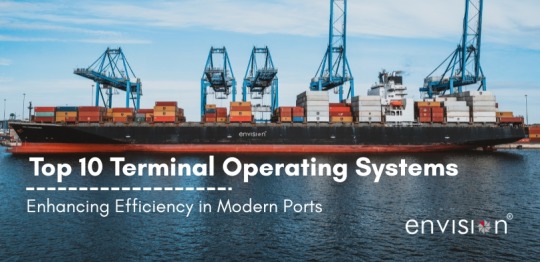
Navis N4
Navis N4 by Navis is one of the most trusted and widely implemented container terminal operating systems globally. It supports terminals of all sizes and integrates effortlessly with other terminal solutions.
Why It's Among the Best:
Innovation, reliability, and scalability-More so container terminal operations have enjoyed these traits attributed to Navis N4 since its inception. In the Navy Computer Corps, decision-making in real-time and timely support for automation have always been some of the very attributes of an industry standard.
Core Functionalities:
Centralized terminal management software
Integrated vessel planning and optimization
Real-time yard truck management system support
Robust container tracking software
Benefits:
Maximizes throughput and equipment utilization
Enhances operational visibility and decision-making
Supports integration with terminal automation systems and automated gate systems
Services and Support:
Navis offers full-scale implementation support, technical consultation, and 24/7 global support. They also provide training and regular software updates.
Deployment and Technology:
Navis N4 supports both cloud-based and on - premise deployments with modular scalability.
Cost Consideration:
Pricing depends on terminal size, modules selected, and level of customization.
Tide works Technology Mainsail Vanguard
Tide works' Mainsail Vanguard is a powerful container terminal software suite known for its flexibility and scalability across multi-terminal facilities.
Why It's Among the Best:
It combines intuitive design with enterprise-grade performance, offering modular options tailored to both smaller terminals and large, multi-user environments.
Core Functionalities:
Real-time operational dashboards
Seamless container yard management system
Interfacing with external systems and third-party tools
Benefits:
Increased transparency and control
Optimized yard operations and terminal productivity
Efficient multi-terminal management
Services and Support:
Includes on-site implementation, dedicated account management, technical training, and round-the-clock technical support.
Deployment and Technology:
Offered as both cloud and server-based solutions with scalable architecture.
Cost Consideration:
Competitive pricing model based on system scope and implementation scale.
Kalmar One
Kalmar One is a comprehensive and modular terminal management system that offers complete automation and equipment integration solutions.
Why It's Among the Best:
Its modular nature allows terminals to implement only the components they need, reducing cost and improving efficiency.
Core Functionalities:
Integrated with container freight station (CFS) software
Support for automated gate system
Modular depot management system (DMS)
Benefits:
Streamlined automation processes
Improved ROI on container terminal automation investments
Scalable from single terminal to global operations
Services and Support:
Global deployment services, maintenance contracts, 24/7 technical assistance, and strategic consultation.
Deployment and Technology:
Supports hybrid deployments with cloud integrations and equipment-level automation.
Cost Consideration:
Modular pricing based on selected features and equipment compatibility.
Cyber Logitech OPUS Terminal
Cyber Logitech’s OPUS Terminal is a next-generation TOS designed to support intelligent operations for container terminals.
Why It's Among the Best:
It enables full-stack container terminal management through integration with IoT, AI, and big data analytics.
Core Functionalities:
Real-time planning and execution tools
Vessel planning and optimization modules
Intelligent yard and berth planning
Benefits:
Enables proactive management of terminal resources
Reduces equipment idle time and energy usage
Scalable and modular architecture
Services and Support:
Offers professional consulting, remote and on-site support, and regular system upgrades.
Deploypment and Technology:
Built on a flexible architecture compatible with both cloud and on - premise environments.
Cost Consideration:
Pricing is dependent on terminal size, desired integrations, and volume throughput.
Envision CTOS by Envision Enterprise Solutions
Envision CTOS is a robust and customizable container terminal operating system developed by Envision Enterprise Solutions. It provides a holistic terminal management system POS platform that supports complex container terminal operations with a strong emphasis on automation, scalability, and adaptability.
Why It's Among the Best:
The key promise of Envision CTOS is that it features an outstanding degree of versatility when dealing with the different types of container terminal operation, such as small regional ports as well as large international gateways. The system is even more configured to be invariably compatible with the total terminal automation area which will lead to digital transformation at all levels of terminal operations.
Core Functionalities:
Integrated container yard management system and container freight station (CFS) software
Real-time terminal solutions and operations monitoring
Scalable multi-terminal architecture and customizable workflows
Seamless compatibility with automated gate systems, yard truck management systems, and depot management system (DMS)
Benefits:
Streamlines operations and minimizes downtime
Future-proof infrastructure with AI-driven analytics
Superior adaptability to specific client needs
Services and Support:
Envision Enterprise Solutions offers end-to-end support including system implementation, user training, 24/7 technical assistance, and custom solution design. Their strong service model ensures that container terminal operators can deploy and operate Envision CTOS with confidence.
Deployment and Technology:
Envision CTOS, constructed on a versatile cloud-based and on location deployment basis, is hybrid-environment-friendly to offer the best reliability. The system combines an AI-based analytics and a container tracking software to help it make improved decisions and operate more efficiently.
Cost Consideration:
Competitive pricing with customizable licensing models based on terminal needs.
TOS+ by RBS
TOS+ by RBS (Real time Business Solutions) is a cloud-native TOS designed for high-performance container terminal operations.
Why It's Among the Best:
TOS+ stands out for its real-time functionality and ease of use, suitable for both large-scale and mid-size terminals.
Core Functionalities:
Integrated modules for quay, yard, gate, and rail operations
Support for container tracking software
Real-time decision engine and predictive analytics
Benefits:
Cloud-native architecture reduces infrastructure cost
User-friendly interface for faster onboarding
Enhanced automation readiness
Services and Support:
RBS provides full project management, implementation services, ongoing training, and 24/7 technical support.
Deployment and Technology:
Offered as a Software-as-a-Service (SaaS) platform with real-time cloud synchronization.
Cost Consideration:
Subscription-based model with flexible pricing tiers.
Inform Logistics SyncroTESS
Inform’s SyncroTESS is a decision support system that enhances terminal operations through AI-driven analytics.
Why It's Among the Best:
SyncroTESS empowers operators with predictive insights, helping optimize equipment usage and terminal layout.
Core Functionalities:
Advanced optimization algorithms
Seamless container yard management system
AI-powered resource scheduling
Benefits:
Reduces operational bottlenecks
Enhances overall container terminal software performance
Predictive accuracy reduces delays
Services and Support:
Provides technical workshops, integration services, and on-call support packages.
Deployment and Technology:
Can be deployed as a stand-alone engine or integrated with an existing TOS.
Cost Consideration:
Custom pricing based on integration level and system scope.
Konecranes TBA Autostore
Auto store by Konecranes TBA is an automation-centric TOS that combines software intelligence with operational efficiency.
Why It's Among the Best:
Autostore leverages simulation and modeling to increase container terminal automation throughput.
Core Functionalities:
Automation-friendly container terminal management system
Advanced simulation for process testing
AI-enabled container tracking software
Benefits:
Reduces handling errors
Increases automation ROI
Lowers operational expenditure
Services and Support:
Includes remote monitoring, training, and technical onboarding.
Deployment and Technology:
Offered with a hybrid deployment model, with simulation tools available on-demand.
Cost Consideration:
High initial setup with scalable pricing for modules.
Jade Master Terminal
Jade Master Terminal is tailored for mixed cargo terminals, combining general and containerized cargo operations.
Why It's Among the Best:
Its all-in-one approach is ideal for ports handling a variety of cargo types without compromising efficiency.
Core Functionalities:
Unified terminal operations software
Dynamic reporting and real-time dashboards
Container yard and vessel planning modules
Benefits:
Simplifies complex cargo workflows
Increases port productivity
Excellent for regional or developing ports
Services and Support:
Comprehensive deployment support and user training, with local partner availability.
Deployment and Technology:
Cloud-enabled with easy-to-integrate APIs.
Cost Consideration:
Affordable pricing for small and mid-sized terminals.
Zebra FX Collect Terminal OS
Zebra FXCollect is a cutting-edge container terminal operating system focused on real-time asset visibility through IoT and RFID.
Why It's Among the Best:
It combines rugged hardware with intuitive software to deliver a high-visibility terminal environment.
Core Functionalities:
Real-time data collection via RFID and IoT
Integrated with depot management system (DMS)
Automated gate system support
Benefits:
Enhances cargo traceability
Improves inventory and logistics control
Minimizes operational risk
Services and Support:
Zebra provides end-to-end support including device integration, remote maintenance, and custom development.
Deployment and Technology:
IoT-driven hybrid platform with scalable cloud support.
Cost Consideration:
Hardware and software bundled or separately priced based on scale.
Conclusion:
The decision on selecting the container terminal operating system can no longer be regarded as an issue of operational comfort, but rather a mission-critical undertaking that has the direct impact on the efficiency, safety, and long-term competitiveness of a particular port. The most effective TOS platforms on the market nowadays provide a full range of advanced features, such as yard truck management systems, vessel planning applications, container tracking software, and even automated gate systems, designed to make the process as efficient and informed as possible.
The ten terminal operating systems which have been examined in this guide provide the cutting edge of technology of port logistics throughout the world. However, the outstanding flexibility, rich functionality, and prospective design of the Envision CTOS make it stand alone amid the rest. Designer to support large scale terminals and regional properties alike, EnvisionCTOS is designed to connect with the terminal automation system you presently use to have full control of all aspects of your container terminal activities.
No matter whether you intend to replace an aged infrastructure model or completely switch to an automated workflow process, Envision CTOS can be your preferred choice in how to go about digital transformation. It has a modular design, backed by exceptional industry support, thus it can be easily deployed, scaled and future-proof.
Move one step forward to the operational excellence. To learn more, and to request a custom demo, get in touch with Envision Enterprise Solutions today to discuss deployment options, and understand how Envision CTOS can support your terminal on its journey into the next generation of smart automation.
#container terminal operating system#multi cargo terminal operating system#terminals#envision enterprise solutions#container shipping#vessel planning and optimization#ctos#container freight station (cfs) software#ai powered port management#ports community management#container tracking software
0 notes
Text
Streamlining Operations: Logistics Software Transforming the UAE Market
The United Arab Emirates, a global trade hub, relies heavily on efficient logistics operations. To maintain its competitive edge, the industry is rapidly adopting advanced logistics software UAE. These solutions are revolutionizing how companies manage their complex supply chains, from warehousing to international shipping.
Freight software solutions UAE are becoming indispensable, offering tools for real-time tracking, route optimization, and automated documentation. For companies dealing with maritime transport, specialized systems like container shipping software UAE, ocean freight software UAE, and sea freight software UAE are essential. These platforms streamline container management, track vessel movements, and facilitate efficient port operations. Additionally, liner software UAE provides specific tools for liner shipping companies, enhancing scheduling and vessel utilization.
Freight forwarding system UAE and freight forwarding management software UAE are critical for companies handling the intricate process of moving goods across borders. Specifically, freight forwarding software Dubai and freight forwarding software UAE address the unique demands of this dynamic market. International freight forwarding software UAE enables seamless handling of customs procedures, documentation, and compliance across various jurisdictions. To manage the financial aspects, freight forwarding accounting software UAE and logistics accounting software UAE offer integrated solutions for invoicing, cost tracking, and financial reporting.
For businesses focused on maximizing cargo space, freight consolidation software UAE helps optimize loading and reduce shipping costs. Cargo shipping software UAE and shipping software UAE provide broader tools for managing cargo movements, including tracking, documentation, and communication. Moreover, shipping management software UAE offers comprehensive oversight of all shipping activities.
To further improve overall efficiency, freight logistics software UAE, freight management software in UAE, and ocean freight management software UAE provide advanced analytics and reporting capabilities, enabling companies to make data-driven decisions.
For companies seeking the best freight management software UAE, solutions offering seamless integration, scalability, and robust security are paramount. Finally, international logistics software UAE provides global supply chain visibility and control.
#logistics software uae#freight software solutions uae#cargo shipping software uae#container shipping software uae#freight forwarding system uae#liner software uae#shipping software uae#freight forwarding software dubai#freight software uae#freight forwarding management software uae#logistics accounting software uae#freight forwarding software uae#international freight forwarding software uae#freight logistics software uae#ocean freight software uae#freight management software in uae#ocean freight management software uae#freight forwarding accounting software uae#freight consolidation software uae#shipping management software uae#sea freight software uae#international logistics software uae#best freight management software uae
0 notes
Text

This blog discusses the potential and might of digital Depot Management Solutions. It details how integrated solutions such as depot management systems (DMS), container depot software, inland container depot (ICD) automation, and container freight station (CFS) management software are important in redefining logistics. We will also discuss how depot management of empty containers, container yard optimization, container tracking and tracing, import/export container logistics, and container drayage management play a crucial role in building a more integrated and resilient logistics ecosystem.
#high potential#ai powered port management#artificial intelligence#depot#container#terminals#software development#software
0 notes
Text
Im making a neocities to replace and improve upon this blog. Very exciting development
#sometimes i feel like a town crier but like#only for things that interest me personally#like just a dude on horseback riding through town at 4am like#''I GOT MY TAX RETURN BACK. IT WAS $103.''#and people go back to sleep#anyway coding is both easier than i ever thought and also very very hard#like#very easy to do super super basic stuff#and people have done a lot of work to make it super easy to get started#there are html generators i found that do the basic foundation leg work for you to start#(super appreciate the people who made those)#and doing small basic edits to a pre existing code is easy#but uh#things get so much more complex#and when you KNOW theres a small error somewhere but you cant find it???#finding the error is like. lowkey brain melting#keeping track of everything when its still in progress is hard#and alao tbh ive always struggled to like#perceive the concept of software#like theres just this disconnect in my head#i have a brick of plastic and metal in my hand#and i can generally understand how it was constructed in specific ways to channel electric charges in a way to cause certain effects#but then the idea that you have this lengthy hypothetical and nontangible logic exercise just. SOMEHOW contained within it.#and that is the key to the physical item doing what you want it to#my brain just really struggles with that#so talking about code too in depth confuses me no matter how accessibly its phrased#just. its a math problem. its word problems. its logic problems. i can solve puzzles.#i cannot comprehend the continuum between the thought puzzles and the chunk of physical material in my hands#anyway#devilman am i right
1 note
·
View note
Text
Best Equipment Rental Software - Features & Benefits
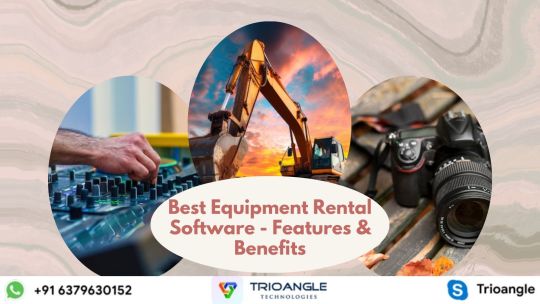
Running an equipment rental business can be challenging, but the right software can make it much easier. Whether renting out AV equipment, cameras, containers, or furniture, specialized rental software can help you manage inventory, track reservations, and streamline customer interactions. But with so many options available, how do you choose the best one?
This guide will walk you through everything you need about equipment rental software, from its key features to how it can benefit your business. Let’s dive in!
1. What is Equipment Rental Software?
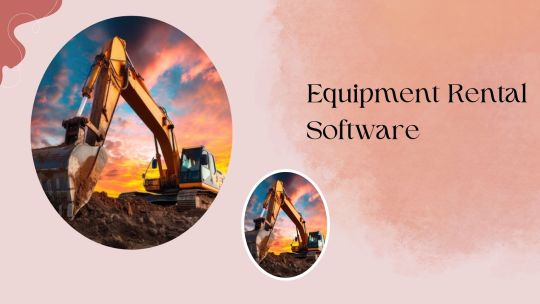
Equipment rental software is a digital solution designed to help businesses manage their rental inventory, track bookings, automate billing, and improve customer service. It eliminates manual processes, reducing errors and boosting efficiency.
2. Key Features to Look For
When choosing rental software, look for these must-have features:
Inventory Management – Keep track of available and rented items.
Online Booking System – Allow customers to book rentals online.
Automated Invoicing & Payments – Streamline billing.
Maintenance Scheduling – Track equipment servicing.
Reporting & Analytics – Gain insights into your business.
3. Types of Equipment Rental Software
There are different types of rental software, each catering to specific industries:
AV Equipment Rental Software
Camera Equipment Rental Software
Container Rental Software
Furniture Rental Software
4. AV Equipment Rental Software
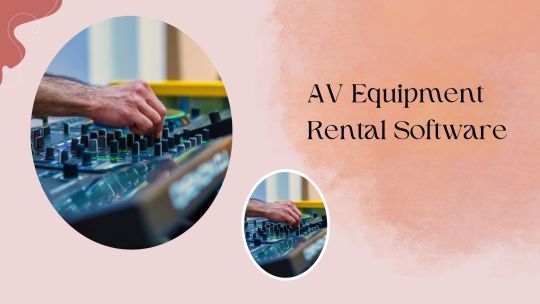
AV equipment rental software is designed for businesses that rent out audio-visual equipment, such as speakers, microphones, and projectors. It helps track availability, manage bookings, and ensure timely returns.
5. Camera Equipment Rental Software

This software is ideal for photographers and videographers renting out cameras, lenses, and accessories. Features like damage tracking, rental agreements, and insurance integration are crucial.
6. Container Rental Software

For businesses renting out storage and shipping containers, this software simplifies logistics, including tracking, maintenance scheduling, and contract management.
7. Furniture Rental Software

From event furniture to office equipment, furniture rental software helps businesses manage their inventory, delivery schedules, and customer orders efficiently.
8. How to Choose the Right Software for Your Business
To pick the best software, consider:
Business size and needs
Budget and pricing plans
Ease of use and customer support
Scalability for future growth
9. Benefits of Using Rental Software
Using rental software can revolutionize your business by:
Reducing errors and improving efficiency
Enhancing customer experience
Streamlining inventory tracking
Boosting revenue with better analytics
10. Common Challenges and How to Overcome Them
Some common challenges include:
Software Learning Curve – Opt for user-friendly software with good support.
High Initial Cost – Look for affordable or subscription-based options.
Integration Issues – Ensure compatibility with your existing systems.
11. Pricing and Subscription Models
Rental software pricing varies based on features and business size. Common models include:
Monthly/Annual Subscriptions – Fixed pricing based on usage.
Per Transaction Fees – Charges based on the number of rentals.
Custom Pricing – Tailored for large businesses.
12. Future Trends in Rental Software
The rental industry is evolving with new technologies, including:
AI and automation for better inventory management.
Cloud-based solutions for accessibility.
Blockchain for secure transactions.
Final Thoughts
Investing in the right equipment rental software can transform your business by automating tasks, reducing errors, and improving customer satisfaction.
Whether you rent AV gear, cameras, containers, or furniture, choosing the right software will help you scale and succeed.
0 notes